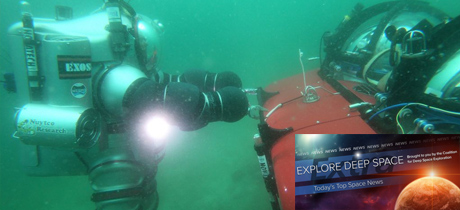In Today’s Deep Space Extra… Multinational astronauts drill in the Pacific to assess training strategies for future Moon missions. Hurricane Dorian moves away from Florida’s Atlantic Coast as teams assess post storm damage to NASA’s Kennedy Space Center (KSC). NASA’s Jet Propulsion Laboratory (JPL) equips the Mars 2020 rover with a small helicopter scout.
Human Space Exploration
Astronauts test retro spacesuit tech for mock Mars missions under the sea
Space.com (9/4): An international team of astronauts recently completed an undersea Pacific Ocean exercise that evaluated training methods for future Moon missions as well as a prototype commercial space suit, called the ExoSuit, for its dexterity.
NASA’s Kennedy Space Center (KSC) in Florida gets all clear as Hurricane Dorian moves on
Space.com (9/4): NASA’s Kennedy Space Center (KSC) received an all clear Wednesday from the lengthy threat posed by Hurricane Dorian, which lashed the Bahamas before moving away from Florida’s Atlantic Coast. A damage assessment team will be comb the launch complex on Thursday to assess damages from high winds and rain. If the team signals it’s safe, workers will resume their regular schedules on Friday.
Hurricane Dorian: This is how Kennedy Space Center (KSC) and Cape Canaveral fared
Florida Today (9/4): The publication offers an initial facility by facility look at how Florida’s Space Coast fared in the face of Hurricane Dorian, which though offshore unleashed 90 mile per hour winds across the region at one point before turning away.
Space Science
Mini-helicopter installed on NASA’s next Mars-bound rover
Spaceflightnow.com (9/4): At NASA’s Jet Propulsion Laboratory (JPL), specialists have installed the prototype small Mars Helicopter to the bottom of the Mars 2020 rover, which is being prepared to launch to Mars in July 2020. Once the rover has landed in February 2021, the 2020 Rover will place the helicopter on the Martian surface and move away. The copter will test its ability to hover, fly, explore and take imagery, activities demonstrating whether a larger version could function as a scout as part of future robotic and human exploration activities.
No digging required: Space mining on the Moon and beyond may be solar powered
Space.com (9/4): A NASA funded research effort suggests that water ice lodged in permanently shaded craters at the Moon’s south and north poles could be mined by exposing it to solar energy. The vapors would condense as they rise from the lunar regolith aboard specially developed rovers. The technique for extracting subsurface water ice, a resource for human life support and conversion to its chemical oxygen and hydrogen components for rocket fuel, may work on distant asteroids as well.
NASA’s record-breaking Parker Solar Probe aces 3rd sun flyby
Space.com (9/4): Over the Labor Day weekend, NASA’s Parker Solar Probe emerged from its third close flyby of the sun, sprinting with 15 million miles of the star at more than 213,000 miles per hour. The $1.5 billion mission was launched in August 2018 to carry out a series of close solar observations. Twenty one more close flybys are planned over the next seven years.
The Spaceline: An elevator from the Earth to the Moon
Universe Today (9/4): Maybe the best place to anchor a space elevator developed to reduce transportation costs between the Earth and the Moon as at the lunar surface. A pair of U.S. and U.K. graduate students propose as much in a study submitted for publication in Acta Astronautica. The elevator concept is long lived and technically challenged.
Other News
NanoRacks, commercial space industry march ahead with Space Station airlock
Coalition Member in the News – NanoRacks
Houston Chronicle (8/28): Nanoracks, the Houston based commercial space company, is well on its way to placing the finishing touches on the first commercial airlock destined for launch to the International Space Station (ISS) in 2020. A more than $20 million investment, the Bishop Airlock will support the launch of small satellites from the orbiting science lab as well as expose experiments to the environment of space.
Will LandSpace be China’s SpaceX?
Space Review (9/3): In China, a commercial space launch industry is emerging. Interstellar Glory, also known as i-Space or Space Honor, claimed the first success with the July 25 launch of two small satellites. But more competitors are emerging and targeting the lucrative liquid propellant, medium payload launch capability market, according to a lengthy assessment from journalists Chen Lan and Jacqueline Myrrhe.

